Union Infantry Guide: Part 2
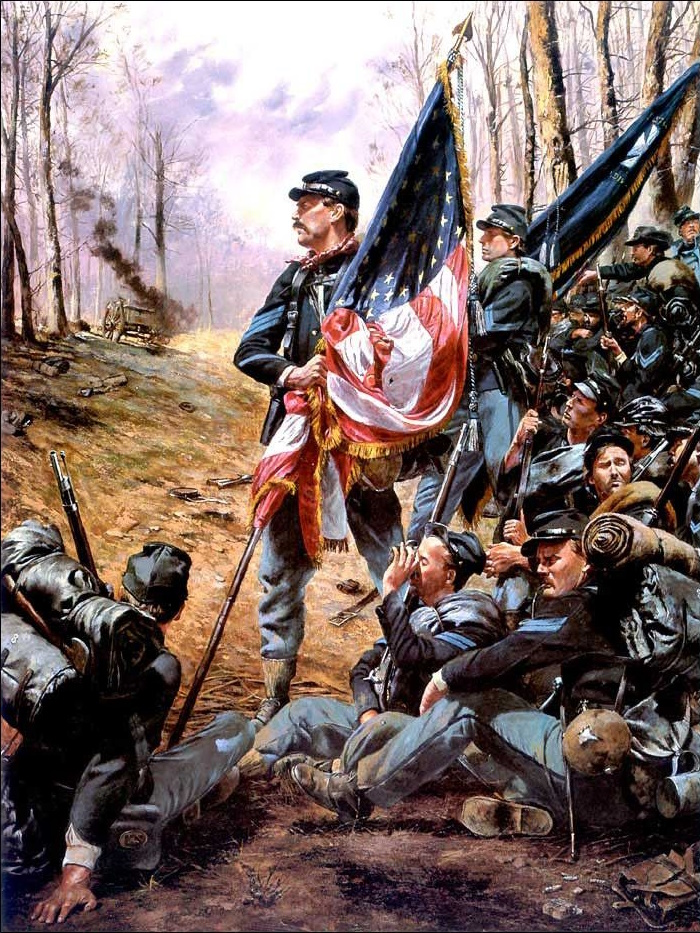
The following is a comprehensive list of all infantry units in the mod that are currently available to the Union. This guide is intended to not only show what units are available, but to also give players a quick reference to where those units can be recruited from in the mod, the weapons they are equipped with, as well as which faction and generals they are assigned to.
This guide is organized according to the type of unit, their home state (in alphabetical order), and their designated number (if applicable).
Infantry
New York
5th New York Volunteer Infantry "Duryee's Zouaves"
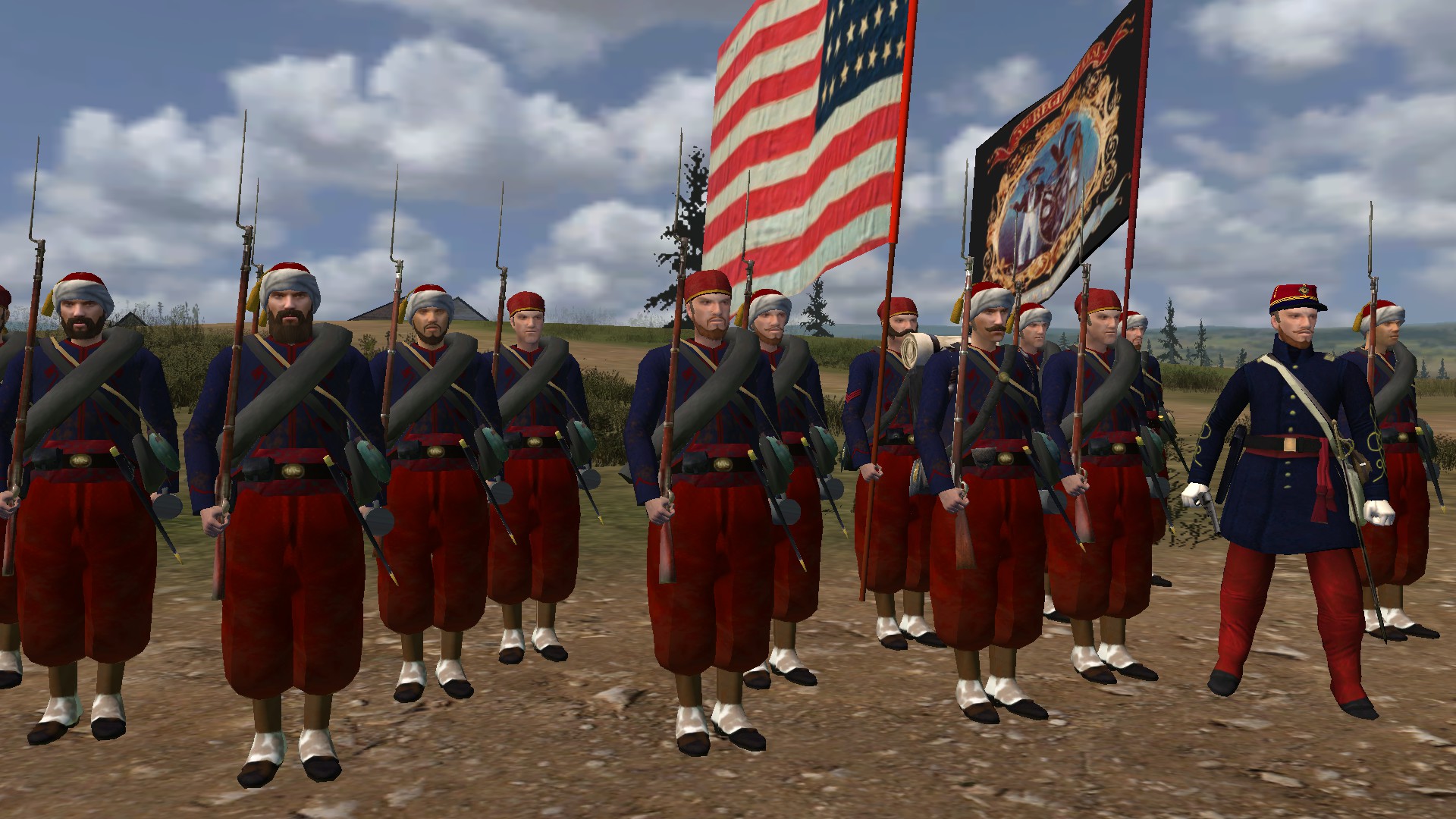
Weapons: Springfield Model 1861 Rifle Musket, Springfield Model 1863 Rifle Musket, Lorenz Rifle Model 1854
Faction: Army of the Potomac
Current Commanders: Major General Gouverneur K. Warren, Brigadier General William H.L. Wallace
Recruitment Locations: Monticello, Utica, Syracuse, Rochester, New Paltz, Rome, Yorktown Heights, Riverhead
The 5th New York Volunteer Infantry, also known as "Duryee's Zouaves", was an infantry regiment in the Union army led by Colonel Abram Duryee. The uniforms of the 5th New York were modeled closely on those of French Zouaves. General George B. McClellan said that, upon seeing the colorful New York regiment, "the Fifth is the best disciplined and soldierly regiment in the Army."
In August 1862, the regiment fell under the control of General John Pope. At the Second Battle of Bull Run (also known as the Second Battle of Manassas), the 5th New York Volunteer Infantry regiment was forced to withstand the advancing forces of General James Longstreet. In underestimating the size of the Confederate army, Pope ordered the regiment to support Hazlett’s Artillery Battery. Longstreet’s soldiers easily outnumbered the small regiment, and the Texas Brigade quickly inflicted over 330 casualties in the regiment. 120 Zouaves were killed within 8 minutes, the greatest single battle fatality of all Federal volunteer infantry regiments in the entire Civil War. The entire Color Guard was killed, except for one man. The only officer to survive the battle was Captain Clevland Winslow.
On December 15th, the regiment fought at the Battle of Fredericksburg, covering the Union retreat, and then fought at the Battle of Chancellorsville under Joseph Hooker. Colonel Cleveland Winslow organized the 5th New York Veteran Volunteer Infantry after the original 5th mustered out, and after a long and difficult recruiting period, the 5th Veterans joined the V Corps and fought in the final campaigns of the Virginia front.
14th Brooklyn Chasseurs "Red Legged Devils"
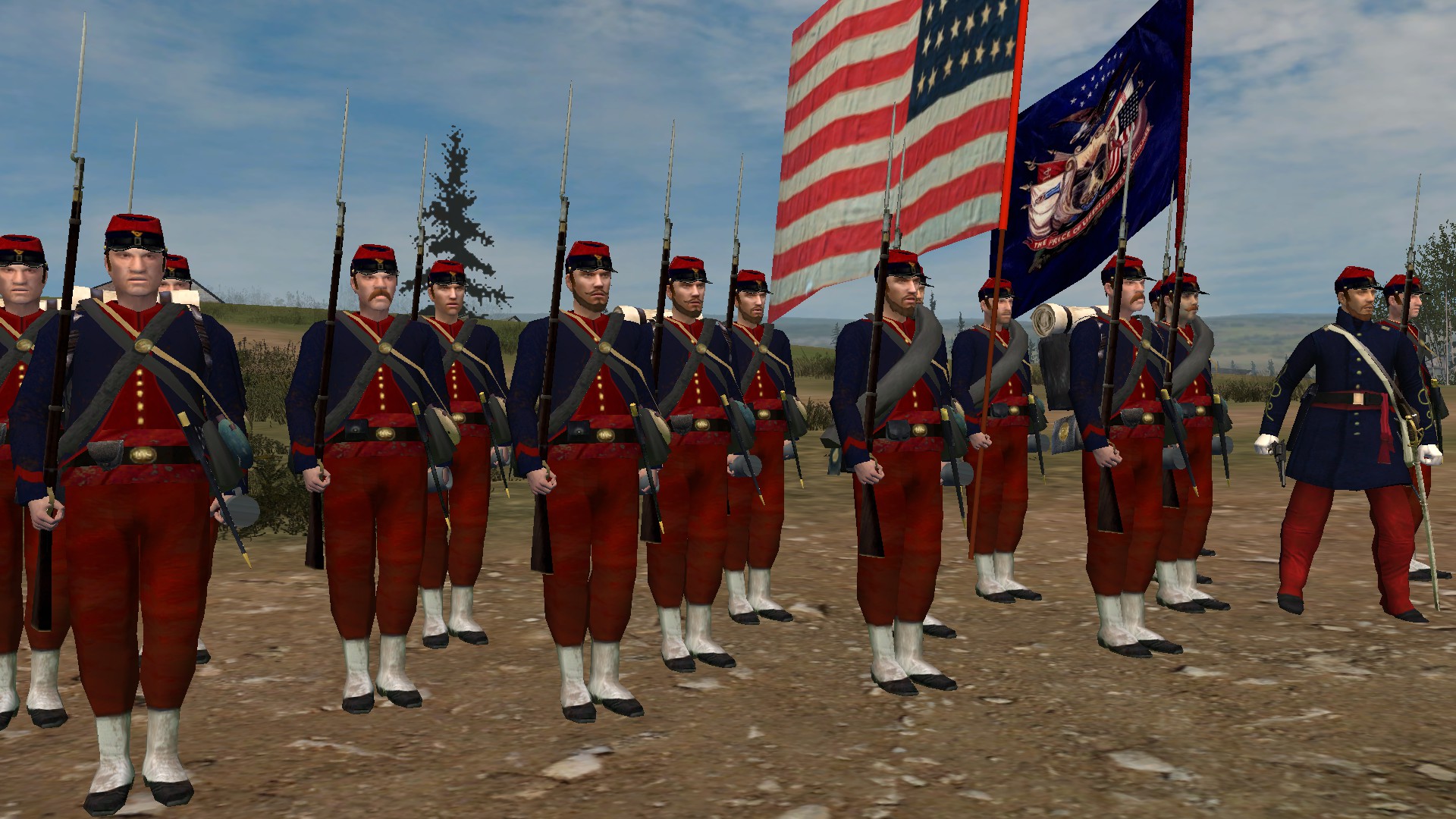
Weapons: Pattern 1853 Enfield Rifle Musket
Faction: Army of the Potomac
Current Commander: Colonel Walter P. Phelps Jr.
Recruitment Locations: New York City, Monticello, West Point, New Paltz, Newark, Yonkers, Yorktown Heights, Melville
The 14th Regiment New York State Militia (also called the 14th Brooklyn Chasseurs) was a volunteer militia regiment from the city of Brooklyn, New York. The regiment was made up of a majority of abolitionists from the Brooklyn area. It was led first by Colonel Alfred M. Wood and later by Colonel Edward Brush Fowler. The 14th Brooklyn was involved in heavy fighting, including most major engagements of the Eastern Theater. Their engagements included the First and Second Battles of Bull Run, the Battle of Antietam, Fredericksburg, Chancellorsville, Gettysburg, The Wilderness, and Spotsylvania Court House. During the war, the men of the 14th Brooklyn were well known by both armies and throughout the country for their hard drill, hard fighting, and constant refusal to stand down from a fight. During their three years of service they never withdrew from battle in disorderly fashion.
At the First Battle of Bull Run, the 14th Brooklyn was assigned to the First Brigade, commanded by Colonel Andrew Porter, in Colonel David Hunter's Second Division in General Irwin McDowell's Army of Northeastern Virginia. The regiment was ordered up to Henry House Hill to reinforce the 1st Minnesota Volunteer Infantry Regiment and the 11th New York Volunteer Infantry Regiment, the "Fire Zouaves". These regiments had been ordered to support two batteries of cannon under the command of Captains Charles Griffin and James B. Ricketts on the Union right flank. The 14th Brooklyn, the 11th New York, and the 1st Minnesota were placed into position by Major William Farquhar Barry, McDowell's chief of artillery, at the crest of Henry House Hill. They were ordered to hold their position and assault if the opportunity was there, but were under no circumstances to leave the guns to the Confederates.
Confusion soon erupted on the battlefield in front of them. Thinking the 33rd Virginia, clad in dark blue frock coats and dark blue trousers, were Union troops supporting the guns, Major Barry ordered Ricketts to hold his fire. This allowed the Virginians to charge the batteries and capture the guns. The 14th Brooklyn, however, rushed up the slope and drove the 33rd Virginia back, recapturing the two guns. The 14th then continued to fire into the left flank of Jackson's line, driving the 33rd Virginia back through the 2nd Virginia Infantry. Under the pressure from the 14th Brooklyn, a large portion of the 2nd Virginia joined the retreating 33rd Virginia and the left of Jackson's line began to collapse. However, Jackson ordered the 4th and 27th Virginia forward, which were joined by the 49th Virginia Infantry, two companies of the 2nd Mississippi Infantry, and the 6th North Carolina Infantry. In hand to hand combat, the 14th Brooklyn were driven back to the Manassas-Sudley Road, and Ricketts' battery and Griffin's two guns were captured. The 14th Brooklyn, the 69th New York Militia and the 11th New York would charge up Henry House Hill four times in an effort to recapture Ricketts' and Griffin's cannons. The other two regiments met with little success, but the 14th Brooklyn found gaps and weaknesses in the Confederate lines and exploited them. The 14th Brooklyn briefly took control of the two guns following one charge, only to be routed yet again by the Confederates. The constant charging of the 14th Brooklyn caught the eye of General Jackson himself. This is when he made his famous statement to his troops, "Hold On Boys! Here come those red legged devils again!", and with that, the regiment received its nickname the "Red Legged Devils".
While the 14th Brooklyn and 11th New York Volunteer Infantry were briefly in control of the two guns, the Louisiana Tigers advanced up the hill. The 14th and 11th fired upon the battalion from their superior position, causing significant losses. The Tigers then fired their own rifles, and the majority of the 14th fell to their knees. Encouraged by this, the Tigers dropped their rifles and took out their Bowie knives in an attempt to finish off the survivors. As the Tigers neared the crest of the hill, the 14th Brooklyn stood up. Though both the 14th Brooklyn and the Tigers, who had left their rifles at the bottom of the hill, were poorly trained and lacked real combat experience, a savage hand to hand fight began between the two units. Though the Tigers fought with ferocity and determination, the 14th Brooklyn had the superior field position and eventually the Tigers retreated back down the hill. This brief confrontation permanently made the 14th Brooklyn and the Tigers rivals. The efforts of the 14th Brooklyn, however, were in vain, and they were immediately flushed from the position yet again by a powerful Confederate counterattack. The two guns would not be retaken again. As the Confederates launched their strong counterattack, the Union army panicked and fled from the field.
At Second Bull Run the regiment again fought courageously, losing nearly 120 men. At Antietam, the 1st Division commanded by Brigadier General Abner Doubleday of the 1st Corps began their attack on the morning of September 17th, 1862 from the North Woods. According to a report from William Fox of the 107th New York, the brigade that composed of the 22nd New York, 24th New York, 30th New York, 14th Brooklyn, and the 2nd U.S. Sharpshooters, was the first to be called the "Eastern Iron Brigade" because of its brave fighting at South Mountain and Antietam. Colonel Rufus R. Dawes the commander of the Sixth Wisconsin later wrote in his book, "Service with the Sixth Wisconsin Volunteers",
"The Fourteenth Brooklyn Regiment, Red legged Devils, came into our line closing the awful gaps. Now is the pinch. Men and officers of New York and Wisconsin are fused into a common mass, in the frantic struggle to shoot fast. Everybody tears cartridges, loads, passes guns, or shoots."
In the cornfield, the Eastern Iron Brigade followed the Western Iron Brigade into battle early in the morning. While the rest of Phelp's brigade fell back, the 14th Brooklyn held its ground along with elements of the 6th Wisconsin of the Black Hats. This effort combined into a mass of soldiers pushing the Confederates up to Dunker Church. These two regiments got further than any other Union Regiment during the attack in the cornfield. At Fredericksburg and Chancellorsville the 14th Brooklyn saw minor action during these two major engagements, however it was during this campaign that the brigade proved that they truly were the "Iron Brigade of the East". During Chancellorsville, the regiment saw a quick but highly deadly action alongside the 6th Wisconsin at Fitz Hugh's Crossing.
The 14th Brooklyn was the last regiment of the 2nd Brigade on the road to Gettysburg, and the men from the brigade were the first infantry units to arrive on the field and fire their rifles on July 1st, 1863. General John F. Reynolds rode up to the 2nd Brigade and urged them on to Gettysburg to support General John Buford's cavalry who were holding the Confederate forces at bay. The 14th dropped its packs on the Emmitsburg road and at the double quick, crossed the same field where General Pickett's men would make their famous charge on July 3rd. The 14th Brooklyn arrived at McPherson's Woods and halted the Confederate advance, until the 1st Brigade of the 1st division arrived. Once the Western Iron Brigade was deployed, Colonel E.B Fowler saw Confederate forces taking cover in an unfinished railroad cut to his right. He commanded his "Demi-Brigade" (14th Brooklyn & 95th NY Volunteer Infantry) across the field to meet and clear out Davis' Confederate Brigade. Held in reserve, the 6th Wisconsin was ordered into the cut to support the 14th Brookyln and the 95th NY Volunteers. Again the 14th and 6th were fighting side by side, as they did in earlier engagements. Into the cut the three regiments rushed, supporting each other equally on each other's flanks. One 14th Brooklyn soldier said of the Confederate defense of the railroad cut, "they fought with the ferocity of wildcats", and the fight became a brawl of hand to hand combat. The Confederates facing them finally realized their position was a death trap and surrendered themselves to Colonel E.B. Fowler, and handed their flags over to the 14th Brooklyn.
The Confederates were able to wheel artillery down and fire on the 14th's position in the railroad cut, and the 14th withdrew from the cut, through the town of Gettysburg, while the 11th corps came up to support the 1st corps so they could refit. The 14th Brooklyn had the honor of carrying General John F. Reynolds' body from the field, into the town of Gettysburg. The regiment continued to fight for the remainder of the battle of Gettysburg, on Culp's Hill on the right flank of the Union army. They were called up to support General Greene who was losing his position to superior numbers. The 14th Brooklyn fought two days up there, and Greene later credited the 14th for helping save the entire Union army by saving the flank. The 14th Brooklyn was called back up the hill after this action, being relieved by the 137th New York. They were there long enough to eat some food and then were immediately sent back down the hill to support the flank once again. Colonel Fowler wrote that when the men entered the trenches, "they did so without a shout, and the regiment remained there until their ammunition was all but exhausted." He also recounted the casualties taken within the trenches were light but that the colors, which rose above the works, were riddled with bullets, and the staff of the state flag was shot through.
The 14th Brooklyn fought for another year, through the Wilderness campaign and Spotsylvania. They finally mustered out in May 1864. The recruits who signed up and joined the regiment in 1862 were moved over to the 5th New York Veteran Volunteer Infantry Regiment. However, the recruits who went over to the 5th New York Veterans (Duryee's Zouaves) wore their 14th Brooklyn uniforms and formed their own company in the 5th. The regiment mustered out at Fulton Ferry on the 25th of May, 1864 to huge crowds who welcomed the regiment home after three years of service. During its time in the war, the regiment sustained 717 casualties, nearly 41% of its men.
20th New York Infantry "Turner Rifles"
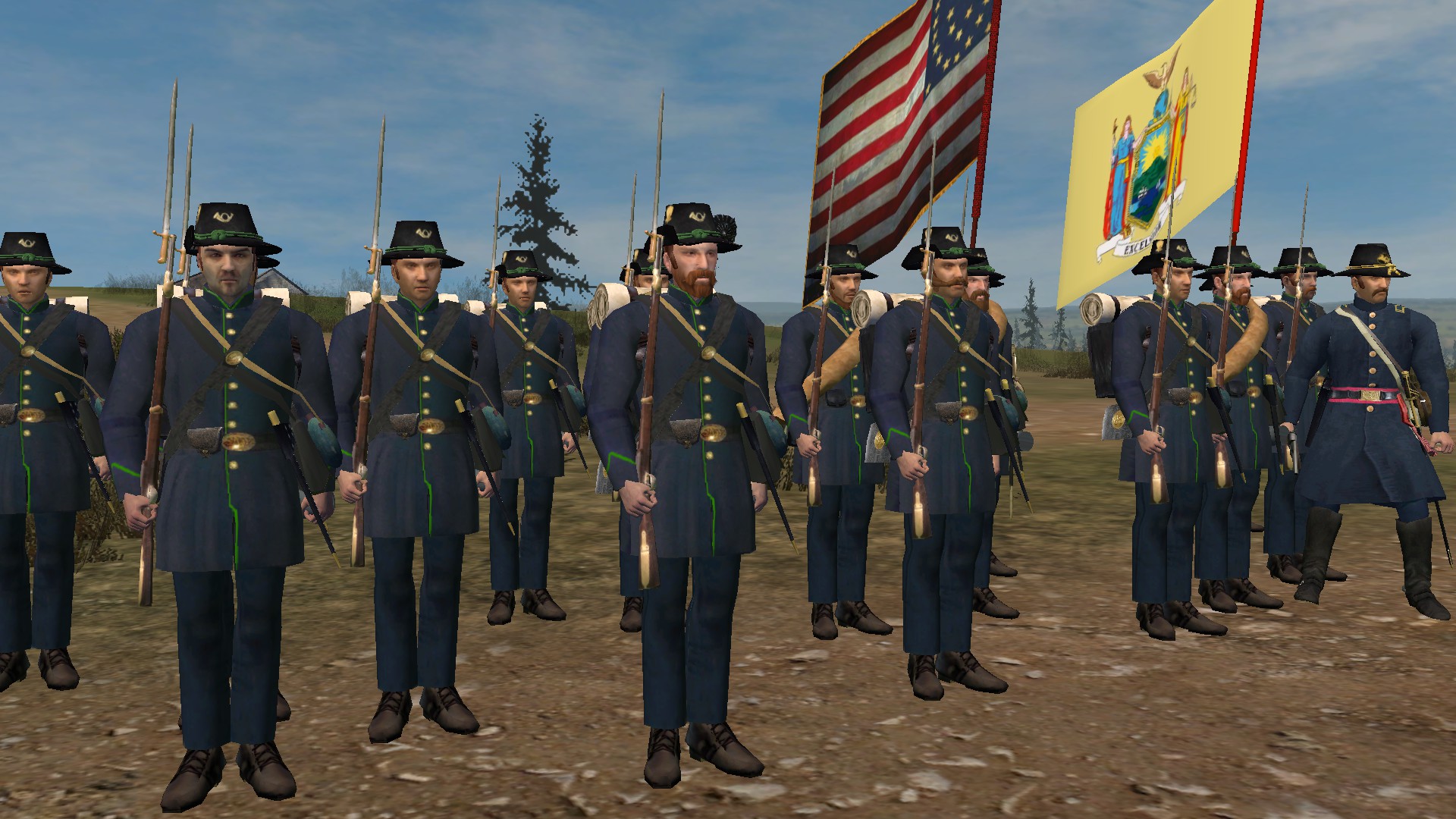
Weapons: M1841 Mississippi Rifle
Faction: Army of the Potomac
Current Commander: Brigadier General August Willich
Recruitment Locations: New York City, Buffalo, Fort Niagara, Utica, West Point, Saratoga, Rochester, New Paltz, Rome, Yonkers, Yorktown Heights, Hudson
The 20th New York Volunteer Infantry, also known as the "Turner Rifles", was mustered into Federal service for two years on May 6th, 1861. Although most of the men were recruited primarily in New York City, several companies of the regiment were formed in upstate New York and New Jersey. The vast majority of recruits came from the various German-American Turner societies, with the largest number coming from New York City's Kleindeutschland neighborhood. Turners are members of German-American gymnastic clubs called Turnverein. They promoted German culture and physical culture, however they were not just athletic but also political and militaristic. Many Turners would fight in the Revolutions of 1848 and favored German Unification, but were defeated. After being suppressed, many Turners would leave Germany and emigrate to the United States, and these migrants would be called "Forty-Eighters". Keeping with their roots, they would become politically involved in America and would support the Union. After the Civil War broke out, many would enlist to fight for the North.
After training in Manhattan's Turtle Bay Park, the regiment left New York for Fort Monroe, Virginia, on June 14th, 1861. They departed with much fanfare, including a parade from Kleindeutschland to their transport ship and the presentation of both an American flag and the Black-Red-Gold flag of Germany's democratic revolutionaries, as well as a guide flag with the motto "Bahn Frei", which means "Clear the Way" in German. To the dismay of the enlisted men, in whom was ingrained the German tradition of marksmanship, the regiment was issued with smoothbore muskets, though these would be replaced by rifles in 1862. The Turners were renowned as good entertainers, and for the 4th of July celebration in 1861, the regiment performed several much-praised concerts, with improvised lighting displays and 50 barrels of lager. The Turners were also known to hold gymnastic performances, and their choral singing was very popular.
While stationed at Fort Monroe, General Benjamin Butler commanded a joint army-navy expedition to capture Confederate occupied Fort Hatteras and Fort Clark. In the ensuing Battle of Hatteras Inlet Batteries, a mixed amphibious force led by the 20th New York's commander, Colonel Max Weber, accepted the surrender of the two forts. The portion of the 20th which had taken part in the invasion remained in the vicinity of Forts Hatteras and Clark for several weeks, until reports reached Major General John Ellis Wool that soldiers from the regiment had committed "depredations and various outrages" on the local civilians. Other sources suggest that the colonel of the 9th New York blamed the looting on the men of the 20th to protect the reputation of his own regiment, which had also participated.
On October 7th, 1861, companies G, H, I & K were ordered to Newport News and on December 22nd, lost 1 officer and 6 enlisted men wounded at the Battle of New Market Bridge, near the town of Newport News. On June 9th, 1862, the 20th New York was transferred to the VI Corps of the Army of the Potomac in preparation for the Peninsula Campaign. The 20th was engaged at the Battle of Savage Station on June 29th, where they were attacked by the 7th and 8th Georgia Infantry, then advanced two miles, followed by a charge on Confederate lines. The regiment was engaged again the next day at the Battle of White Oak Swamp, in which a Confederate artillery bombardment surprised the 20th New York as they were encamped. A significant number of the enlisted men and officers were routed, including the regiment's new commander, Colonel Francis Weiss. As one eyewitness and future Medal of Honor winner in the 7th Maine Infantry remembered, the soldiers of the 20th New York,
"wore high, conical, black hats, and when they broke and ran the plain was dotted far and wide with their hats and knapsacks. It is a tradition in our regiment that they are running still, and their colonel, who days before was talking about the blood he was going to shed, and who certainly led the wild flight several lengths, may not have stopped, for he was never heard from afterwards."
Other officers at the brigade and divisional levels, however, reported that much of the regiment, though startled and disorganized, regrouped in the shelter of nearby woods to await the end of the bombardment. In the days following the debacle at White Oak Swamp, nine officers were forced to resign their commissions, and Colonel Ernst von Vegesack, a Swedish officer who earned the Medal of Honor for his actions at the Battle of Gaines’ Mill, was appointed to command the regiment. The 20th lost 2 killed, 10 wounded and 20 captured or missing in the surprise attack on the camp.
The 20th New York was present for the battles of Malvern Hill, Harrison's Landing, and Crampton's Pass at South Mountain, but was not engaged in major combat until the Battle of Antietam on September 17th, 1862. The regiment suffered heavy losses, losing 9 officers and 42 men killed, 100 wounded and 2 missing, but their performance during the battle earned them praise from their superior officers. Their action in checking the final Confederate counterattack near Dunker Church even earned the praise of the observer who had criticized their flight at White Oak Swamp.
The 20th New York went on to participate in the Battle of Fredericksburg from December 12th to the 14th, where they crossed the Rappahonnock river and supported the batteries to the east of the town. After the withdrawal back across the river on the 15th, the regiment moved to White Oak Chapel and went into winter quarters, building huts. On January 20th, 1863, the regiment participated in the Mud March, a failed offensive aimed at trying to approach the Confederate capital of Richmond by crossing the Rappahannock River.
As the 20th New York closed in on the end of its two years of service, questions arose as to whether the two years started from the point at which they were mustered into New York service or United States service. On April 29th, 1863, the regiment was involved in maneuvers which would lead to the Battle of Chancellorsville. When ordered to cross the Rappahannock River, approximately two hundred men refused to do so. The mutineers were quickly tried and convicted for mutiny in the face of the enemy, and sentenced to hard labor. Lobbying efforts by Kleindeutschland elites and the support of Army of the Potomac Provost Marshal Marsena R. Patrick led to their sentence being commuted to dishonorable discharges, although these discharges were converted to honorable discharges by a declaration by the war department and a law passed by Congress in 1905.
The remainder of the regiment crossed the Rappahannock and participated in the Battle of Salem Church on May 3rd, in which the regiment suffered higher casualties than at any other battle. The next day on May 4th, the 20th fought at the Battle of Banks' Ford and was on the right flank of the advanced Union line of defense, on the high ground just north of the Plank Road. It was attacked by Early’s Brigade and held for an hour and a half of heavy fighting, when Colonel Ernst von Vegesack was wounded. When he fell the regiment broke and ran for the rear. The 20th New York lost 9 enlisted men killed or mortally wounded, 6 officers and 83 enlisted men wounded, and 4 officers and 106 enlisted men captured.
The regiment withdrew across the Rappahannock river on May 5th, and on May 6th, the regiment’s term of service expired. Three years men transferred to the 3rd New York Battery and to Battery F, 5th United States Artillery. The regiment marched to Falmouth Station to board trains for Washington on May 7th, and when they passed through Baltimore on the 8th, they were honored by a torchlight procession by the Baltimore Turnverein. They arrived in New York on May 10th, and mustered out of service on June 10th, under the command of Colonel Von Vegesack, Lieutenant Colonel Schnepp and Major Meyer. Over the course of its service, 8 officers and 53 enlisted men were killed or mortally wounded and one officer and 58 enlisted men died of disease.
39th New York Infantry "Garibaldi Guard"
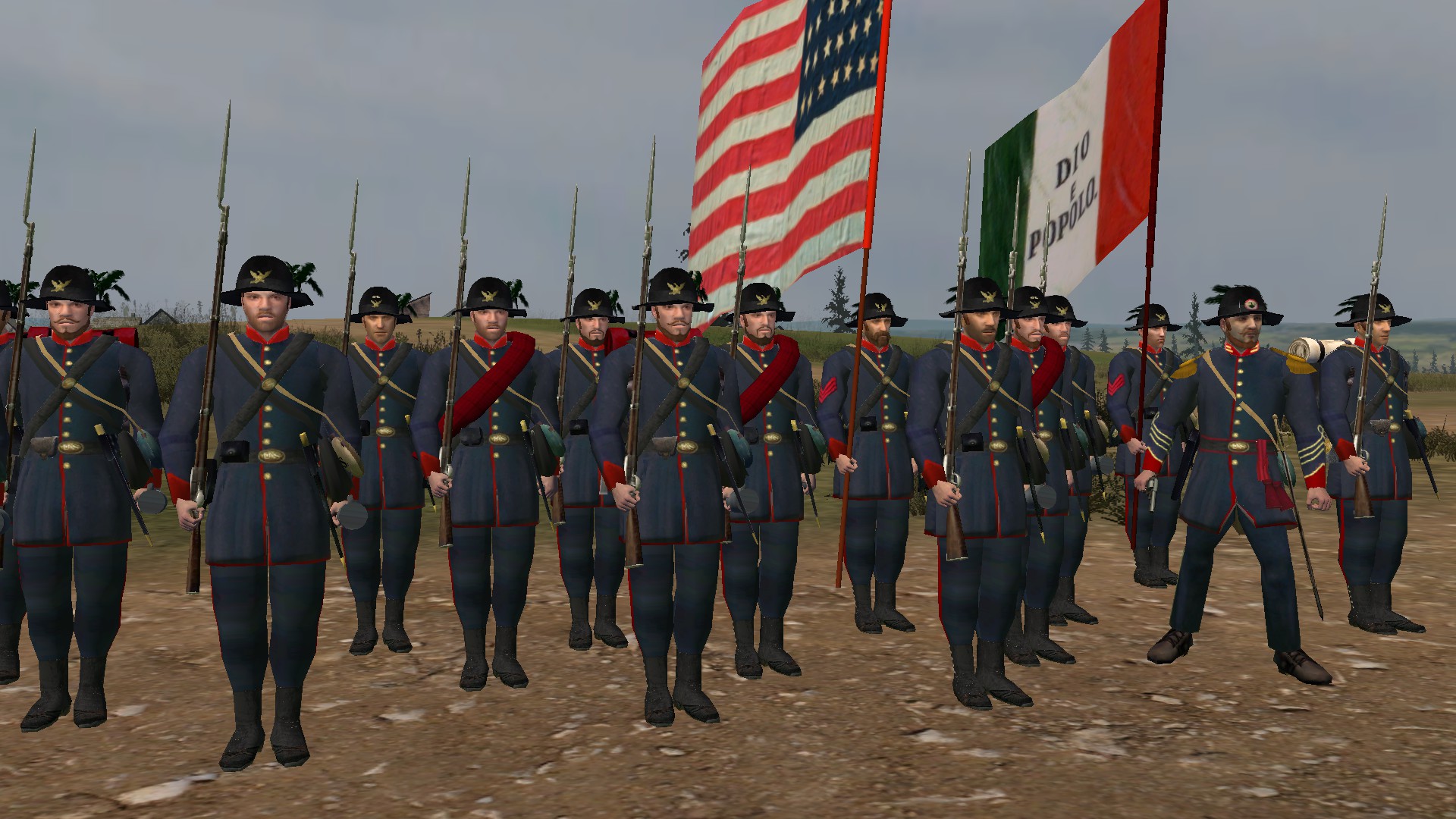
Weapons: (Buck & ball) Springfield Model 1842 Smoothbore Musket
Faction: Army of the Potomac
Current Commander: Brigadier General James S. Wadsworth
Recruitment Locations: New York City, Albany, Buffalo, Fort Niagara, West Point, Saratoga, Newark, Yonkers, Yorktown Heights, Hudson, Riverhead, Melville
The 39th New York Infantry Regiment, known as the "Garibaldi Guard" after the Italian revolutionary, Giuseppe Garibaldi, was raised by the Union Defense Committee under special authority from the War Department, and was organized and recruited at New York City. Frederick George D’Utassy, would be elected colonel of the regiment despite his somewhat shadowy past. It would not take long for the men of the Garibaldi Guard to realize that they were being commanded by one of the most outrageous, thieving, rogues ever to wear the uniform of the Federal armies. Initially, the regiment was divided into eleven companies of men of different national heritage: three German, three Hungarian, one Swiss, one Italian, one French, one Spanish, and one Portuguese. On May 31st, 1863, the regiment was consolidated into four companies: A, B, C and D. The regiment expanded as new companies were recruited in the field.
In April, 1862, the division was assigned to General Fremont's command and joined his forces May 11th, taking part in the engagements near Strasburg and at Cross Keys. On June 26th, the 39th was assigned to the 1st brigade, 3rd division, 2nd corps of the Army of the Potomac, under General Pope, and encamped at Middletown, Virginia, during July and August. The regiment shared in the disaster at Harper's Ferry in September 15th, 1862, and in the surrender, 530 of its members fell into the hands of the enemy, but were paroled and proceeded to Camp Douglas, Chicago. They were exchanged in November, returned to Washington, D.C. and established winter quarters at Centerville. In June, 1863, the regiment became part of the 3rd brigade, 3rd division, 2nd corps, and moved to Gettysburg, where it fought valiantly in the front of the left center of the Union line, with a loss of 95 killed and wounded, and the 3rd brigade as a whole losing six field officers killed or seriously wounded. Three battle flags were captured by the 39th, a Massachusetts battery was recaptured, and the regiment received official commendation for its valor.
After the battle of Gettysburg, the Garibaldi Guards moved southward with the army, and the regiment encountered the Confederates at Auburn Ford and Bristoe Station in October, participated in the Mine Run campaign, and went into winter quarters at Brandy Station. In February 1864, the regiment was active at Morton's Ford, was assigned in March to the 3rd brigade, 1st division, 2nd corps, and shared in the Wilderness campaign, being engaged at the Wilderness, Todd's tavern, the Po river, Spotsylvania Court House, North Anna, Totopotomoy and Cold Harbor. On June 25th, 1864, the original members who had not reenlisted, were mustered out at New York City, and the remainder of the regiment was left in the field and moved with the Army of the Potomac to Petersburg. Seven companies, known as the 39th battalion, were assigned to the consolidated brigade, 2nd corps, and were engaged at Petersburg, Deep Bottom, Reams' Station, Hatcher's Run, White Oak Ridge, and in the final assault on the Petersburg fortifications on April 2nd, 1865.
The battalion then joined in the pursuit of Lee's army and performed various routine duties in the vicinity of Richmond until July 1st, 1865, when it was mustered out at Alexandria. During its period of service, 5 officers and 62 enlisted men were killed in action; 3 officers and 49 enlisted men died of wounds received in action; 1 officer and 158 enlisted men died of disease and other causes. In total, 278 men, including 9 officers and 269 enlistees, died while in service in the regiment. Of those, 1 officer and 99 enlisted men died while captured by the Rebel army.
45th New York Volunteer Infantry "5th German Rifles"
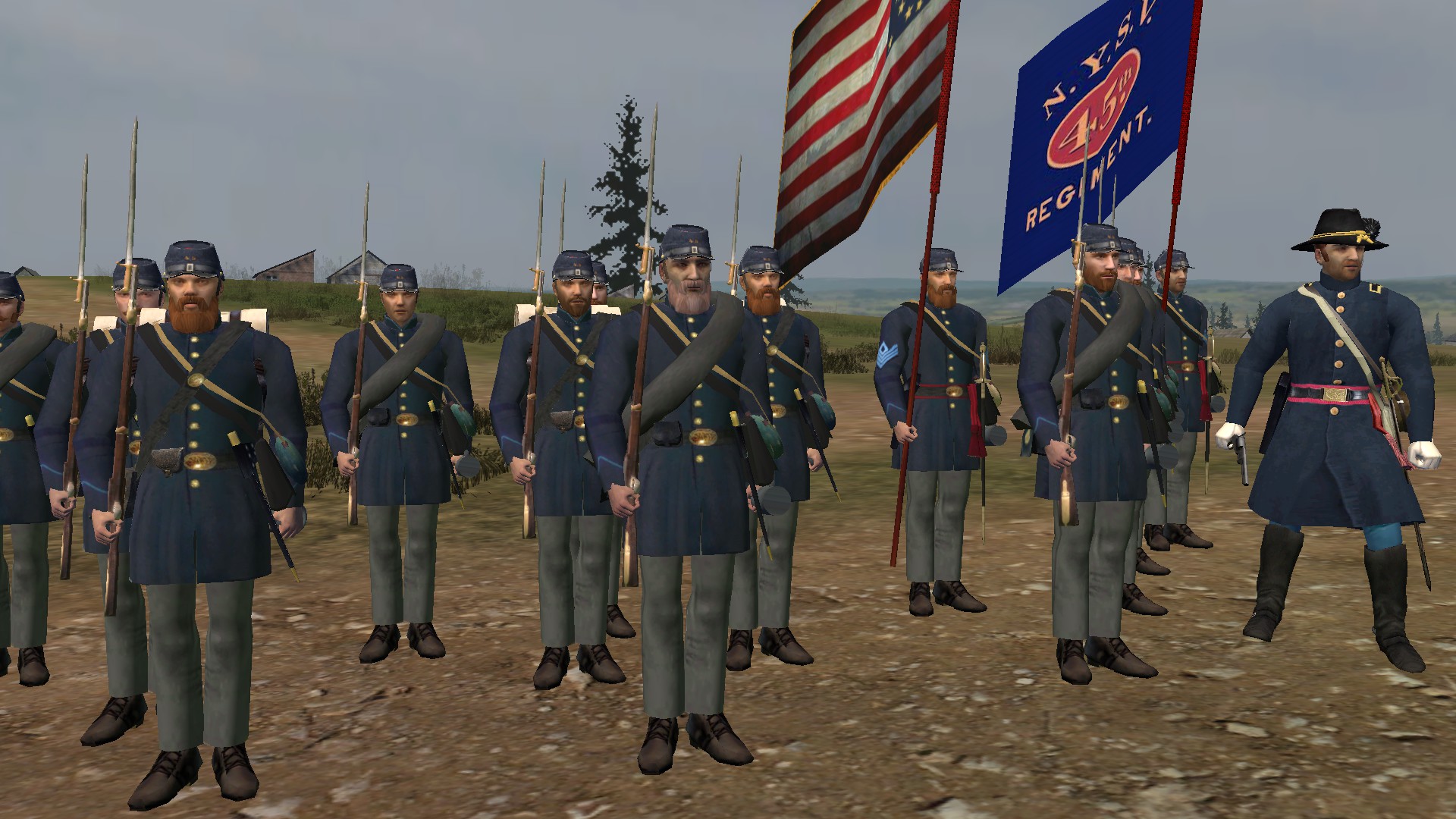
Weapons: M1841 Mississippi Rifle
Faction: Army of the Potomac
Current Commander: Brigadier General Alexander F. Schimmelfennig
Recruitment Locations: Albany, Buffalo, Fort Niagara, Utica, West Point, Saratoga, New Paltz, Rome, Yorktown Heights, Hudson, Riverhead
The 45th New York Volunteer Infantry Regiment, also known as the 5th German Rifles, served with the Union army almost the entirety of the war and saw action in several noteworthy battles, in both the Eastern and Western Theaters. The regiment was composed almost entirely of German immigrants and was organized in New York City by Colonel George von Amsberg, a veteran Austrian cavalry officer and revolutionary in the Hungarian revolution of 1848.
On December 2nd, 1861, while stationed in winter quarters at Hunter's Chapel, the regiment saw its first action of the war in a skirmish several miles to the south-west at Annandale, Virginia. Pickets of Company A were surprised by Confederate cavalry, who had been mistaken for Union forces. It was during this engagement that the regiment also received its first casualties, all from Company A, with private Carsten Huhnenberg killed in action and 12 others missing. On June 8th, 1862, the 45th was engaged at the Battle of Cross Keys, where the regiment suffered a total of 19 casualties. During this battle the regiment took part in a three hour assault on a Confederate position in the woods on the road to Port Republic, which included hand to hand fighting with bayonets. In July and August, the regiment was ordered to Sperryville, Madison Court House, Gordonsville, Cuylersville, Cedar Mountain and White Sulphur Springs. The regiment was engaged in skirmishing at Freeman's Ford and White Sulphur Springs in what is collectively referred to as the First Battle of Rappahannock Station. At the end of August 1862 the regiment was engaged in the Second Battle of Bull Run, under the command of Lieutenant Colonel Wratislaw. In the course of General John Pope's campaign between August 16th, 1862, through Second Bull Run, the regiment suffered 47 casualties.
Major General Oliver Otis Howard replaced General Franz Sigel in command of the XI Corps, and, in the spring of 1863, was in command during the Battle of Chancellorsville. Howard, despite having been ordered to do so, failed to take action to protect his flank. The 45th was assigned to the 1st Division, under the command of General Charles Devons, and this division bore the brunt of a concentrated Confederate attack to the exposed Union right flank on May 2nd, 1863. Devons' division collapsed under the onslaught of over 20,000 Confederates under the command of Lieutenant General Thomas J. "Stonewall" Jackson. During the battle, the 45th suffered 76 casualties, including killed, wounded, and missing.
In June 1863, the regiment, still with XI Corps under Howard, was assigned to 3rd Division, 1st Brigade, and was deployed to Gettysburg. On July 1st, 1863, the first day of battle at Gettysburg, the 45th Regiment was among some of the earliest Union units to arrive on the field, with the XI Corps following shortly after the I Corps. The XI Corps arrived before noon, with the 1st Division leading. The division was sent north to deploy to Oak Ridge, on the right of the I Corps. However, finding that the movement
of Confederate forces prevented this action, they were forced to take position in a broad plain east of the ridge and north of the town. In order to cover the necessary ground with limited forces, the 45th deployed as skirmishers in this location at about 11:00 a.m. They were immediately subject to heavy fire of grape, canister, solid shot, and shell from Confederate batteries on the hill. At 1:30 p.m., a Confederate movement on the extreme left of the 45th and right of the I Corps exposed its flank to the 45th at very short range and was the target of a withering crossfire between the 45th and I Corps. This formation suffered heavy casualties, with survivors taken prisoner and sent to the rear.
At 4:00 p.m., due to a weakening of the lines in this area, the 45th was ordered to retreat, and it fell back to the Seminary with orders to cover the retreat of I and XI Corps through the town. After they had passed, the regiment was ordered to follow them, and a running battle through the streets of Gettysburg ensued. Eventually the regiment turned down an alley and emerged into an enclosed square, the only exit of which had been blockaded by Confederate sharpshooters with the bodies of dead Union soldiers. Only about 100 men, one third of the regiment, escaped this situation to assemble behind a stone fence on Cemetery Hill. The rest were killed, captured, or missing. The regiment remained in relative quiet in this position until 4:00 p.m. the next day, when Confederate batteries opened a heavy fire on Cemetery Hill. The regiment was ordered to the relief of XII Corps on Culp's Hill that evening and returned to Cemetery Hill at daylight. On July 3rd, volunteer sharpshooters from the regiment were employed against Confederate artillery and assisted in repelling Pickett's charge. In total, the regiment suffered 224 casualties at Gettysburg. Captain Francis Irsch was awarded the Medal of Honor for, "Gallantry in flanking the enemy and capturing a number of prisoners and in holding a part of the town against heavy odds while the Army was rallying on Cemetery Hill".
After Gettysburg, the remaining men of the 45th were gathered together and the XI and XII Corps of the Army of the Potomac, under the command of Major General Joseph Hooker, were moved to the Western Theater to reinforce the Army of the Cumberland around Chattanooga, Tennessee. From October 27th to the 28th of 1863, the regiment was engaged in the Battle of Wauhatchie, just outside Chattanooga. These actions were initiated to protect the "cracker line" – the recently established supply line by which Union troops, effectively under siege in and about Chattanooga, were being supported. The regiment suffered two casualties in this engagement and subsequent movements. After Wauhatchie and Lookout Valley, the 3rd Division under Major General Carl Schurz, was temporarily put under the command of William Tecumseh Sherman in support of his assault on the Confederate right on Missionary Ridge. 3rd Division played a supporting role on the Union left in the Battle of Missionary Ridge, however it was not heavily engaged, and suffered no casualties. In April 1864 the XI and XII Divisions were consolidated and designated XX Corps. The 45th was assigned to the 2nd Brigade, 1st Division, XX Corps, with which it served in the Atlanta Campaign through July 1864. It was present for the battles of Dallas, Resaca, and Kennesaw Mountain, however, it did not perform a major role in these engagements and suffered no casualties in the campaign.
In July 1864, the 45th was attached to the Department of the Cumberland at Nashville, Tennessee. It remained there until the close of the war. Original members who did not reenlist were mustered out on October 8th, 1864. Enough reenlisted, however, that the unit was retained as a veteran regiment. It was present for the Battle of Nashville on December 15th to 16th, 1864. On June 30th, 1865, it was consolidated with the 58th Regiment New York Volunteer Infantry and with it mustered out of service on October 1st, 1865.
58th New York Infantry "Polish Legion"

Weapons: (Buck & ball/rifle mix) Springfield Model 1842 Smoothbore Musket, Pattern 1853 Enfield Rifle Musket
Faction: Army of the Cumberland
Current Commander: Brigadier General Włodzimierz Krzyżanowski
Recruitment Locations: Albany, Buffalo, Fort Niagara, Utica, Saratoga, Syracuse, Rochester, Rome, Hudson, Riverhead, Melville
The 58th New York Infantry Regiment, also called the Polish Legion, was a regiment composed almost entirely of immigrant volunteers, mostly including Poles, but also Germans, Danes, Italians, Russians, and Frenchmen, most of whom were recruited at New York City in 1861. In August 1861, Włodzimierz Krzyżanowski, a Polish officer who had fought in the Greater Poland Uprising of 1848, was authorized by United States Secretary of War Simon Cameron to recruit a regiment. Krzyżanowski recruited about 400 men, whom Krzyżanowski called the United States Rifles. The regiment was constituted October 19th, 1861, by consolidating four companies recruited by Krzyżanowski and six companies previously consolidated by Frederick Gellman. Krzyżanowski was commissioned a colonel, and Gellman a lieutenant colonel.
The appearance of the Polish Legion was distinctive, with a red collar and cuffs adorned with with buttons of an eagle on a shield, and the state seal of New York. The regiment's Polish heritage was also showcased with their caps, called a czapka, which was adorned with a golden eagle emblem. On June 8th, 1862, the regiment faced battle for the first time at Cross Keys, Virginia, in which Frémont's forces were defeated by a Confederate corps under the command of General "Stonewall" Jackson. The 58th New York made a bayonet charge in which the Confederate line was driven back about 100 yards (90 m), and Captain Louis Schirmer of the 2nd Independent Battery, New York Light Artillery, reported of the "great gallantry" with which the regiment supported his battery during the battle.
The Polish Legion went on to fight in the Second Battle of Bull Run, where they were actively engaged with Confederate forces, suffering 14 men killed, 32 wounded (including those mortally), and 11 missing. Under the command of Captain Frederick Braun, the regiment then marched to Chancellorsville, Virginia, where it engaged in the Battle of Chancellorsville in May, 1863. When Jackson made his famous flanking attack on the XI Corps, the regiment was engaged in fighting during which Braun was shot and mortally wounded on his horse, with Captain Emil Koenig assuming command. At the Battle of Gettysburg, two companies of the 58th New York engaged in the battle on the first day on the north side of the town, and fell back through the streets to Cemetery Hill with the rest of the army. During the second day, the regiment supported artillery on Cemetery Hill, which began counter-battery fire against Confederate batteries on Benner's Hill in the afternoon. The Confederate artillery barrage inflicted numerous casualties upon the XI Corps, including the 58th's regimental adjutant, First Lieutenant Louis Dietrich, who was struck by one of these missiles and killed, while several others in the regiment were also killed or wounded.
At dusk, Harry T. Hays' Louisiana Brigade (Louisiana Tigers) and Robert Hoke's North Carolina Brigade assaulted the Union position on East Cemetery Hill, and attained a temporary success by charging up the slope and through the cannons of Captain Michael Wiedrich's Battery I, New York Light Artillery, driving the gun crews from their weapons. Led by Major General Carl Schurz in person, the Polish Legion and the 119th New York Volunteer Infantry Regiment hastened to the rescue of the artillery, however the Confederates were repulsed without their assistance. On the morning of July 3rd, the regiment moved to the right of the Baltimore Pike leading into Gettysburg, and one company was sent forward to take possession of the houses on the outskirts of Gettysburg. During the day, Confederate sharpshooters kept up a continuous fire on these houses. The regiment joined the pursuit of General Robert E. Lee's defeated Army of Northern Virginia, and crossed the Potomac River, returning to Virginia on July 19th.
In September, 1863, the XI Corps and the XII Corps were ordered to the Western Theater to assist General Rosecrans' Army of the Cumberland. The regiment was present at the night combat Battle of Wauhatchie, Tennessee on October 28th, 1863, and at the Battle of Missionary Ridge on November 23rd, 1863, suffering slight casualties. At the conclusion of the American Civil War, the regiment proceeded to Nashville, Tennessee, in September, 1865, where it was paid and discharged on October 1st, 1865.
69th New York Infantry "Irish Brigade"
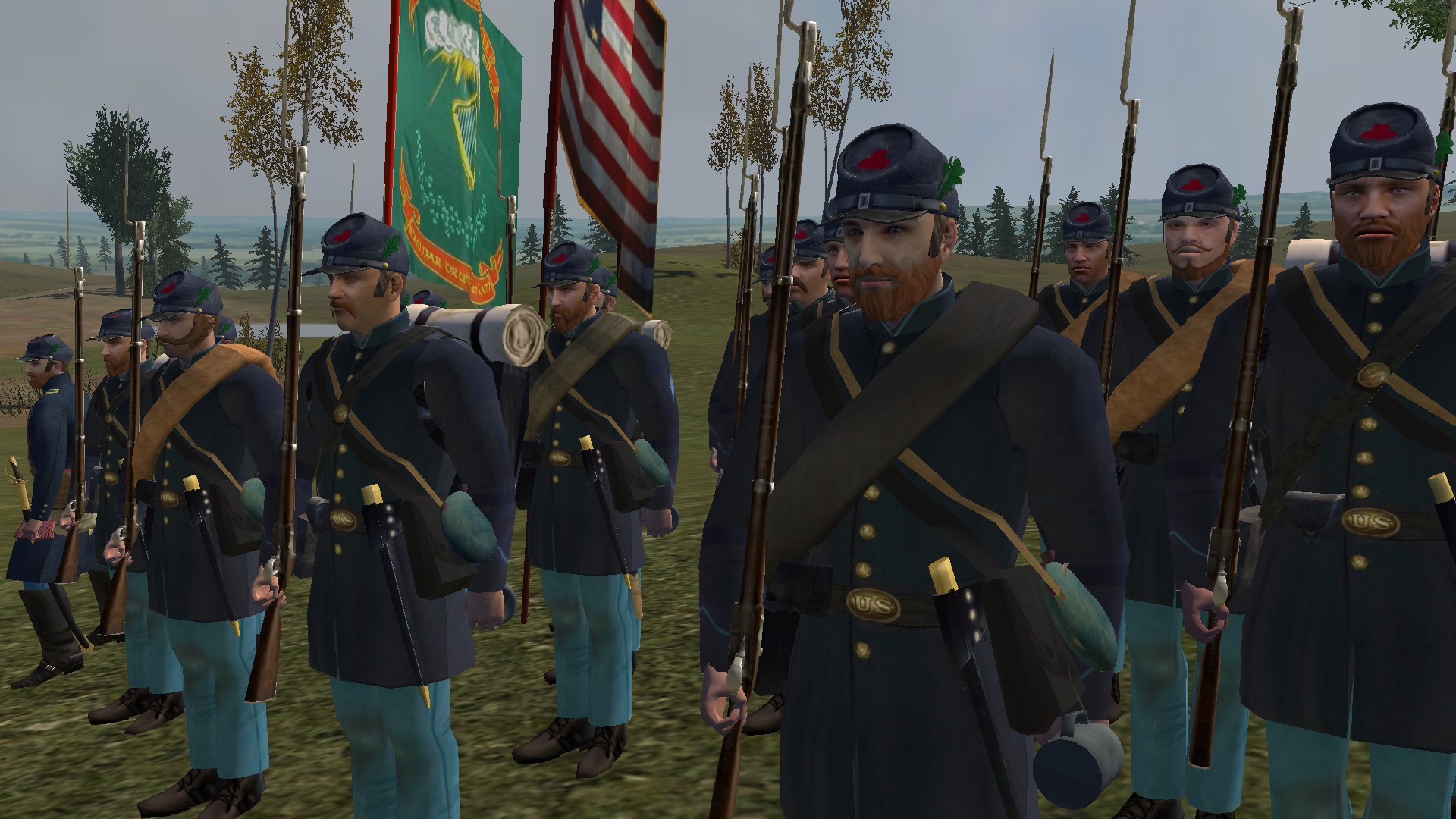
Weapons: (Buck & ball) Springfield Model 1842 Smoothbore Musket
Faction: Army of the Potomac
Current Commander: Major General Edwin Vose Sumner
Recruitment Locations: New York City, Albany, West Point, Syracuse, Rochester, Newark, Yonkers, Hudson, Riverhead, Melville
The Irish Brigade was an infantry regiment in the Union army consisting predominantly of Irish Americans. The Irish Brigade was known in part for its famous war cry, "Faugh a Ballaugh", which is an anglicization of the Irish phrase, fág an bealach, meaning "clear the way". According to Fox's Regimental Losses, of all Union army brigades, only the 1st Vermont Brigade and the Iron Brigade suffered more combat dead than the Irish Brigade during the American Civil War.
At the First Battle of Bull Run (First Manassas), the regiment served under the command of Colonel William T. Sherman and was one of the few Union regiments to retain cohesion after the defeat, despite the wounding and capture of their commanding officer, Colonel Corcoran, by Confederate forces. The 69th served as the Army of the Potomac's rear guard during the disorganized retreat to the defenses of Washington D.C.
After Bull Run, Thomas Francis Meagher applied to have the 69th New York Volunteer Militia reorganized into Federal service as the core unit of a larger brigade composed predominantly of Irish immigrants. Meagher was promoted to brigadier general and designated the brigade's commander. The Irish Brigade distinguished itself from the rest of the Army of the Potomac by Meagher's insistence on arming the 8 line companies of each New York regiment with Springfield Model 1842 Smoothbore Muskets, an obsolete weapon that was largely phased out during 1862, because he wanted his men to be able to fire buck-and-ball shot (a .69 caliber musket ball with four smaller balls), which produced a shotgun effect in close-range combat and could not be used with rifles. The three original New York regiments carried Model 1842 muskets all through the Army of the Potomac's campaigns and battles in 1862–63, using buck-and-ball shot with deadly effect in the Wheatfield on July 2nd at Gettysburg.
Meagher assumed his brigade would perform most fighting at close range where smoothbores were effective, and his officers generally agreed. The majority of the soldiers continued to use their Model 1842 muskets through the Overland Campaign until the depleted outfit was temporarily broken up in June 1864. By 1864, officers had at last realized the power of rifles and firing was now typically being done from distances of up to 200 yards. There are relatively few complaints on record from the enlisted men about their outdated muskets, although one veteran recalled that "we were sometimes at a disadvantage because of the short range", and that he had to pick up a discarded rifle from the field at Antietam to deal with Confederate skirmishers.
The brigade suffered its most severe casualties in December 1862 at the Battle of Fredericksburg where its fighting force was reduced from over 1600 to 256. The brigade was involved in the northern battleground at Fredericksburg where they assaulted the sunken road in front of Marye's Heights. Coincidentally, one of the Confederate regiments manning the sunken road defenses was a predominantly Irish Regiment commanded by Brigadier General Thomas Reade Rootes Cobb. Knowing that Cobb's men manned the wall, and that both Cobb's and Meagher's units contained members of the Irish Republic Brotherhood, an organization dedicated to gaining military experience in the United States, then freeing Ireland from Britain after the war, Lee ordered reserves sent to the position. He need not have worried. Cobb's men helped devastate the Irish Brigade before the reinforcements Lee sent could settle into place. It was at Fredericksburg that Lee allegedly referred to Meagher's regiment as the "Fighting 69th".
After the Battle of Fredericksburg, General Meagher again requested to recruit the brigade back to strength. This time the request was denied. In May 1863, the brigade sustained further casualties at the Battle of Chancellorsville; Meagher repeated his request to recruit replacements, was denied, and resigned his commission in protest. While continuing to serve with distinction, casualties continued to increase and by June 1864 the Irish Brigade had been reduced to regimental size. The US Army disbanded it and incorporated the remaining elements of the brigade into the 3rd and 4th Brigades of the 1st Division, II Corps. A Second Irish Brigade was reformed from the old Irish Brigade regiments as well as the addition of the 7th New York Heavy Artillery, later replaced by the 4th New York Heavy Artillery in early 1865.
79th New York Infantry "Cameron Highlanders"
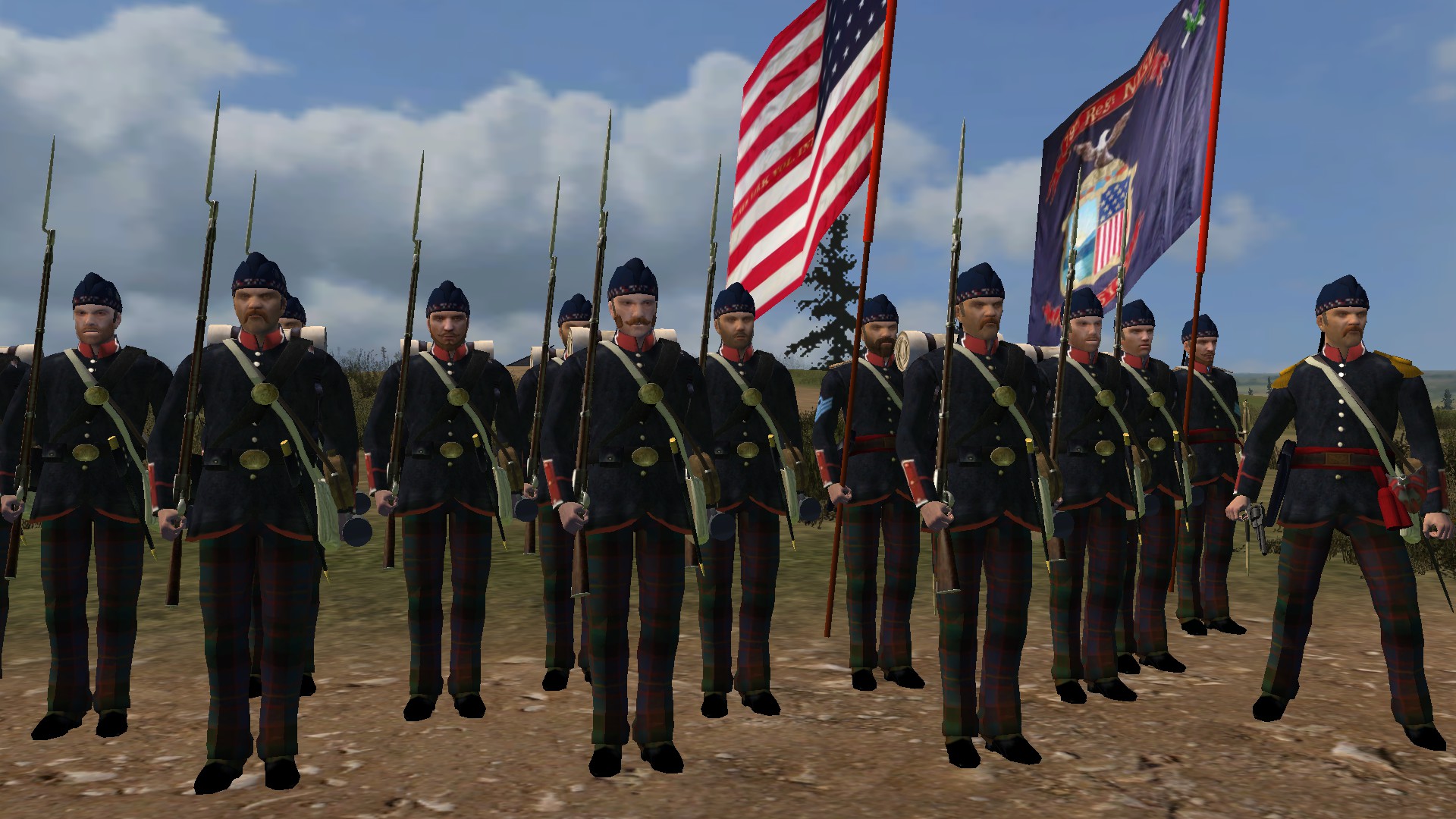
Weapons: (Buck & ball) Springfield Model 1842 Smoothbore Musket
Upgrades to: Pattern 1853 Enfield Rifle Musket
Faction: Army of the Potomac
Current Commander: Brigadier General John Pope
Recruitment Locations: New York City, Albany, Monticello, Saratoga, Syracuse, New Paltz, Yonkers, Melville
The 79th New York Infantry Regiment, nicknamed the "Cameron Highlanders", was one of the most widely recognized and well traveled regiments in the Union Army during the American Civil War. The 79th New York was established in the fall of 1858 in response to the State of New York requiring the 2nd New York to conform to the new uniform regulations. The Highland Guard/79th New York was created with the help of the St. Andrews and Caledonian societies of New York and wealthy financial backers like Samuel M. Elliot and Roderick W. Cameron, who felt the need for a "kilted" regiment that would reflect the heritage of the many Scots in the city. It should be noted that the 79th New York Highlanders had no connection to the 79th Cameron Highlanders of Scotland.
The Scottish-themed uniforms were a standout feature of the regiment, consisting of a Highland Cut Coat of dark indigo blue, applied false red cuffs, a blue collar which was trimmed with red facings with a small white piping line behind it, tartan trousers, and Glengarry bonnet. When on parade, the 79th wore the kilt, going against the wishes of the New York Militia, which wanted them to only wear trousers. While most Union soldiers wore practical yet monotonous blue uniforms, the colorful 79th New York added a splash of vibrancy to the battlefield.
When the war broke out in 1861, the Highlanders were mobilized and, as the regiment was under strength, new men were quickly recruited before they left New York City. The regiment was initially mustered into service for a three-year duration on May 29th, 1861, and on June 2nd, the 895 strong Cameron Highlanders, complete with pipe band, marched down Broadway in New York City on its way to Washington. The 79th New York went on to fight in numerous engagements throughout the Civil War, including but not limited to such famous examples as the First and Second Battles of Bull Run (Manassas), Antietam, Fredericksburg, the Siege of Vicksburg, the Siege of Jackson, the Battle of the Wilderness, Spotsylvania Court House, Cold Harbor, and Petersburg. The regiment quickly became known for their fighting spirit and rugged determination, something the Confederates learned first hand on many occasions.
By the end of the war, those veterans whose term of enlistment had expired returned to New York City, where they were discharged. Less than 130 of the regiment's original members were left. Those with unexpired service were sent to guard Confederate prisoners bound for Alexandria. After the surrender of Robert E. Lee at Appomattox, the regiment moved back to Washington and took part in the Grand Review of the Armies on May 23rd, 1865. It continued duties at Washington until the men were eventually mustered out of Federal service on June 14th, 1865, whereupon the regiment returned to state militia status. New glengarries were sent for the regiment by the Ladies of the New York Scottish Society to wear for their re-entry into New York City.
Over the course of the war, the 79th New York lost 198 killed, plus 304 wounded or missing, out of a total enrollment of 2,200 men.
146th New York Infantry "Garrard's Tigers"
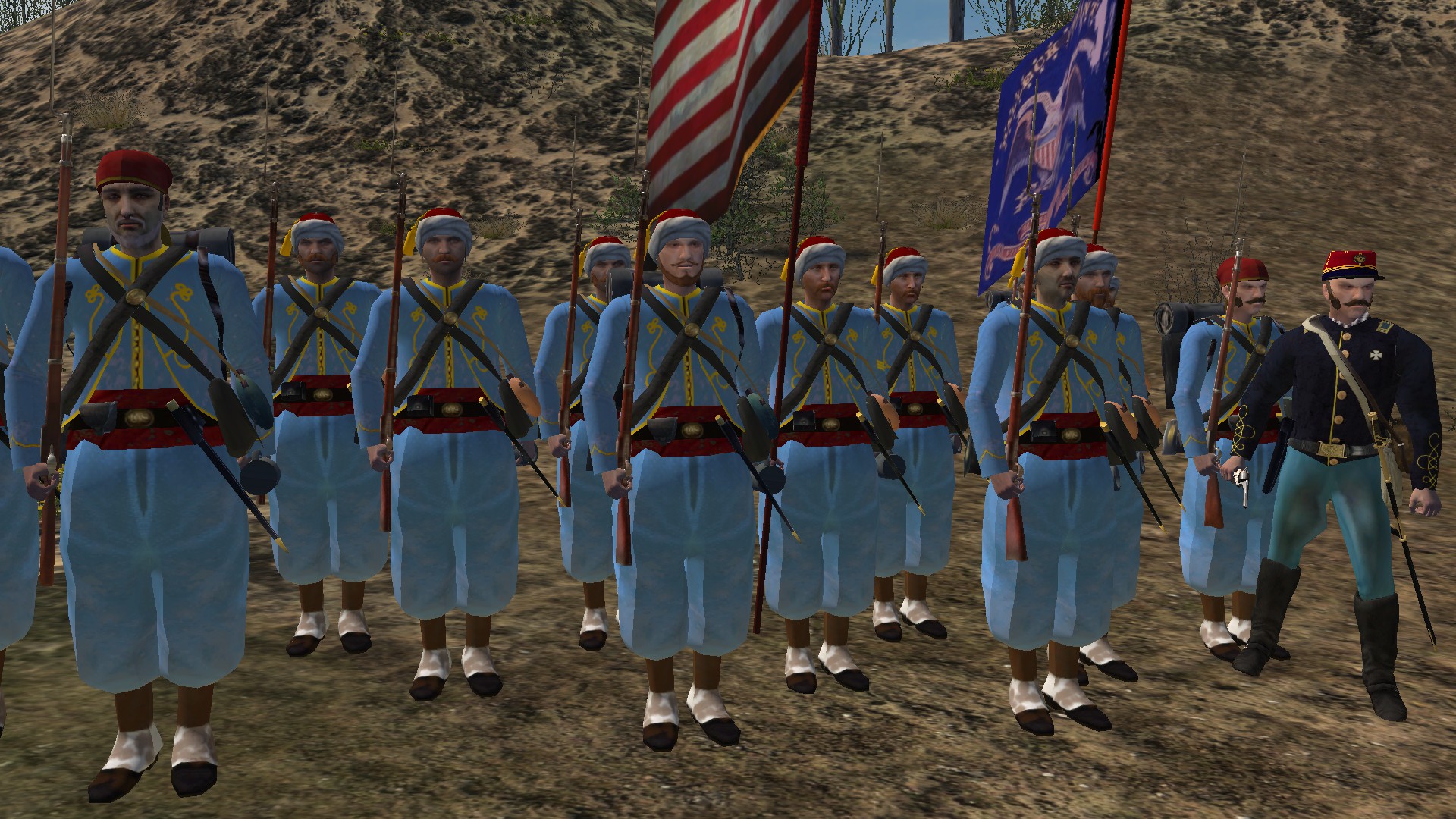
Weapons: Springfield Model 1855 Rifle Musket, Springfield Model 1861 Rifle Musket, Springfield Model 1863 Rifle Musket
Faction: Army of the Mississippi
Current Commander: Major General Henry W. Halleck
Recruitment Locations: Buffalo, Fort Niagara, Utica, Syracuse, Rochester, Rome
Mr. Henry S. Armstrong received authority on August 25th, 1862, to recruit the 146th New York Volunteer Infantry Regiment in Oneida county. It was organized at Rome, with Kenner Garrard as Colonel, and there mustered into the service of the United States for three years on October 10th, 1862. Major General George B. McClellan and Colonel Gouverneur K. Warren had envisioned an entire "Zouave Brigade" a year prior. "These regiments are to be organized, armed equipped, and uniformed in the same manner as the 5th Regiment of New York Volunteers", instructed McClellan following the Battle of Antietam. Unfortunately, a few units were assigned elsewhere and the ability to issue Zouave-type uniforms wasn't feasible at the time. As chance would have it, a major event transpired that allowed for the creation of the "Garrard's Tigers" uniform. For many Federal units, their two year enlistment terms were expiring. Among them were the 5th New York Volunteers, the famous Duryee's Zouaves, however some 325 men who had joined after the regiment's formation were still required to finish out their service. It was decided that 234 veterans of the 5th New York were to be transferred to the ranks of the 146th. Thus, because of the influx of the 5th New York's veteran members, the men of the 146th New York were reissued similar zouave dress to appear a cohesive regiment. Specific details about the regiment's uniform are mentioned in the unit's history, "Campaigns of the 146th Regiment, New York State Volunteers":
"The zouave uniform consisted of large baggy trousers , blue in color, which were fastened at the knees; a fez cap, bright red in color, with red [or yellow] tassel; a long white turban which was wound around the hat, but worn only for dress parade; a red sash about ten feet long which was wound around the body and afforded a great comfort and warmth; and white cloth leggings extending almost to the knees."
The 17th New York Infantry was also transferred into the 146th New York, and in 1864, men from the 2nd, 9th, 16th, 8th, 30th, 34th, 37th and 44th New York Infantry Regiments joined the regiment as well. The regiment left the state on October 11th, 1862, for Washington D.C. and in November, joined the Army of the Potomac at Snicker's Gap, Virginia, where it was placed in Warren's Brigade, Sykes' Division, V Corps, a division chiefly composed of regulars. It marched with this command to Fredericksburg, where it fought its first battle, losing one mortally wounded and 17 missing or captured. At Chancellorsville the regiment suffered heavily on the first day of the fight and acquitted itself with honor, losing 5 enlisted men killed or mortally wounded, one officer and 13 enlisted men wounded, and two officers and 29 enlisted men missing or captured. At Gettysburg it again fought gallantly, losing seven enlisted men killed or mortally wounded, and two officers and 19 enlisted men wounded. Colonel Kenner Garrard took over command of the brigade on July 2nd when Brigadier General Stephen Weed was mortally wounded, and Lieutenant Colonel David Tuttle took command of the regiment. Colonel Garrard was promoted to brigadier general on July 25th for his conduct at Gettysburg.
The regiment participated with little loss in the subsequent Virginia campaigns, ending with that of Mine Run, being present at Rappahannock and Bristoe Stations. At the Battle of the Wilderness, the regiment was almost annihilated when many of the men were cut off by the fires that broke out during the battle. Colonel Fox in his account of this regiment says,
"The regiment encountered its severest fighting at the battle of the Wilderness, May, 1864, where it suffered a terrible loss, not only in killed and wounded, but in captured men. Colonel Jenkins and Major Curran were killed in that bloody encounter, while the total loss of the regiment was 20 killed, 67 wounded and 225 captured or missing".
At Spotsylvania Court House, the regiment lost eight enlisted men killed or mortally wounded, as well as one officer and eight men wounded. On May 12th, the regiment assaulted the salient on Laurel Hill and Captain James Grindlay of Company D was promoted to major on May 18th. At Cold Harbor, the regiment lost four enlisted men killed or mortally wounded and seven enlisted men wounded. The 146th was held in reserve at the Mine Explosion during the Siege of Petersburg and at the Weldon Railroad, lost one officer and five enlisted men killed or mortally wounded, four enlisted men wounded and 35 enlisted men captured or missing. The regiment went on to fight at Poplar Springs Church, Peeble’s Farm, Boydton Plank Road, Hatcher’s Run, and Warren’s Raid on Weldon Railroad.
In 1865, the regiment was in Winthrop's Brigade of Ayres' Division, and was prominently engaged in that command at the battles of White Oak Road, where the regiment lost 13 men killed or mortally wounded, and Five Forks, with General Winthrop being killed in the latter engagement while leading the brigade in a successful charge. The regiment lost one officer and four enlisted men killed or mortally wounded, three officers and 23 enlisted men wounded and 21 enlisted men missing or captured. Colonel Grindlay earned the Medal of Honor for being one of the first to enter the Confederate works. The losses to the regiment in the final Appomattox campaign, were 65 killed, wounded and missing. After the surrender of Robert E. Lee and his army, the regiment participated in the Grand Review and was mustered out near Washington D.C. on July 16th, 1865. Its total enrollment during service was 1,707, of whom seven officers and 126 enlisted men were killed and mortally wounded, and two officers and 187 men died of disease and other causes. One officer and 87 enlisted men died in captivity, many at the Andersonville prison camp.
Ohio
21st Ohio Infantry
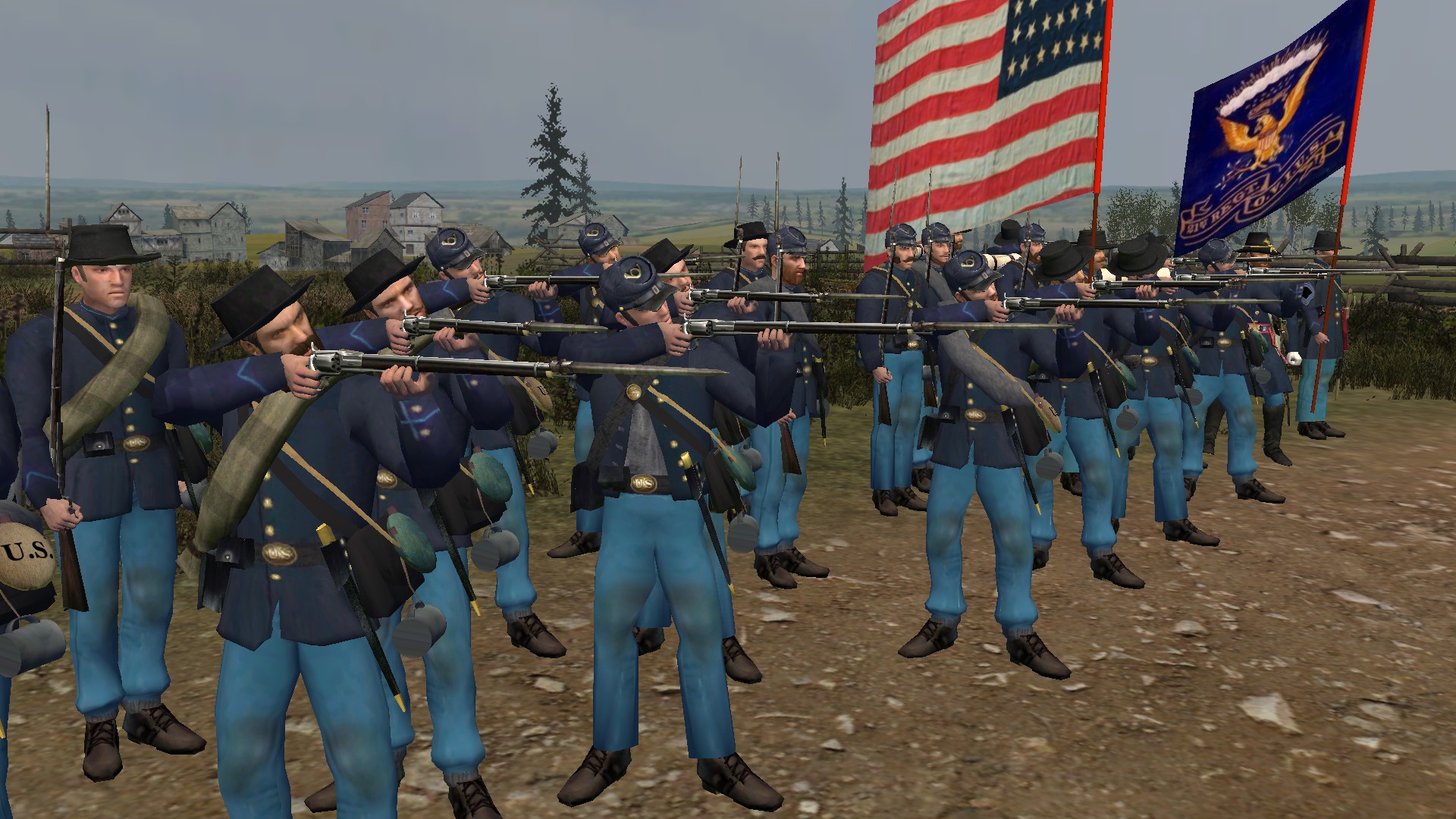
Weapons: M1855 Colt Revolving Rifle
Faction: Army of the Cumberland
Current Commander: Major General William S. Rosecrans
Recruitment Locations: Frankfort, Columbus, Cleveland, Cincinnati, Salineville, Camp Nelson, Lexington, Burkesville, Mount Sterling, Wheeling, Parkersburg, Jackson OH, New Wilmington, Camp Dick Robinson, Findlay
With the exception of a few draftees, the 21st Ohio Infantry was an all-volunteer unit that served for both 90-day and 3-year enlistments exclusively in the Western Theater. Many of the recruits were farmers and farmers' sons who had spent years taming the Great Black Swamp, a place that many believed no white man (and few Indians) could live, in order to cultivate the rich soil beneath it. Other early volunteers were merchants, lawyers, school teachers, blacksmiths, politicians and a county sheriff who was a veteran of the Mexican–American War. Among the privates, Thomas W. Custer, a younger brother of General George A. Custer, and Edward S. Godfrey, would later win the Medal of Honor (Custer won two), and both would go on after the war to fight with the 7th Cavalry at the infamous Battle of the Little Bighorn in 1876.
In the eagerness to embrace new repeating firearms technology, Wilder's famed Lightning Brigade received Spencers and other units got Henry rifles, however the 21st Ohio opted for the five-shot Colt Revolving Rifles. While there were not enough for all eight companies, six of the eight received the Colt rifles, while the other two companies exchanged the motley collection of muskets typically carried by Western regiments for English-made Pattern 1853 Enfield rifles. The five-shot Colt rifles were received with wonder, as few of the men had seen any kind of repeating rifle before. Despite the Colt rifle's reputation as an unsuccessful experiment in the history of gun design, the Ohioans made no loud or lasting complaints about it. They weighed the fast-shooting, quick-loading ability of the Colts against the slow and cumbersome muzzle loaders, and counted themselves extremely lucky. In order to work around the Colt's design flaws, the men adopted an unorthodox grip on the rifle that lessened the danger to their hands from the tendency of the rifle to blast out gas from the cylinder and experience chain fires, which would discharge all five cartridges at once.
The 21st Ohio first witnessed the deadly potency of their new weapons when they embarked on the Tullahoma Campaign, marching and skirmishing through Tennessee and northern Georgia. The regiment experienced it's most well-known action at the Battle of Chickamauga on September 19th to the 20th, 1863, where for six hours they murderously beat back repeated Confederate onslaughts at Snodgrass Hill throughout the morning and afternoon of September 20th. The volume of fire they unleashed was so intense, that the Confederates were convinced that they were attacking an entire division, not just a single regiment. They were expecting musketry; a single volley followed by ragged shots, but instead they ran head long into an unbroken wall of lead that offered no pause and no intervals. By late afternoon, the 21st Ohio was desperately low on ammunition, and the soldiers began to frantically search the cartridge boxes of their dead and wounded comrades. When this supply was depleted, a runner was sent to the rear to search for more, but quickly discovered that the ordnance trains had left with the rest of the retreating Union army. At dusk, the regiment retired to the rear of Horseshoe Ridge, having expended all of their ammunition, a total of 43,550 rounds.
The order to fix bayonets was issued to the regiment, and they were tasked with occupying the extreme right flank. They managed to procure one last round of ammunition for each man, and after firing their last rounds, the men remained in their position and were quietly captured. Out of the 540 men deployed by the 21st Ohio, 265 had been killed, wounded or captured in the fighting. 46 men would eventually be sent to Andersonville prison, where only ten of the prisoners would survive their captivity.
The 21st went on to form part of the assaulting column that carried the crest of Missionary Ridge, participated in the Atlanta Campaign under William T. Sherman, and marched through Georgia to Savannah, arriving on the coast at the end of the year. In early 1865, the 21st participated in the Carolinas Campaign, seeing their final action at the Battle of Bentonville. Following the surrender of the Confederate army, the regiment marched to Washington and participated in the Grand Review of the Armies, before being paid and discharged from the army on July 28th, 1865.
34th Ohio Infantry "Piatt's Zouaves"

Weapons: Springfield Model 1861 Rifle Musket, Pattern 1853 Enfield Rifle Musket, Springfield Model 1855 Rifle Musket
Faction: Army of the Cumberland
Current Commander: Brigadier General James B. Ricketts
Recruitment Locations: Columbus, Cleveland, Cincinnati, Salineville, Mount Sterling, Toledo, Fremont, Huntington, Wheeling, Parkersburg, Jackson OH, New Wilmington, Findlay
The 34th Ohio Volunteer Infantry was a three-year regiment raised at Camp Lucas near Cincinnati on September 1st, 1861 by Abraham S. Piatt at his own personal expense. Most of the recruits came from the western part of the state, and they are well known for wearing an Americanized zouave uniform which consisted of a dark blue jacket with red trimming, a pair of sky blue baggy trousers with two red stripes going down vertically, a pair of tan gaiters, and a red Ottoman styled fez with a blue tassel. The organization’s members adopted the nickname, "Piatt's Zouaves", after the regiment's founder, Colonel Abraham S. Piatt, and their zouave uniforms.
After training and drilling, the new regiment moved to Camp Dennison on September 1st, and then embarked trains for the front lines. They initially served in the forces under General George B. McClellan, and then under a variety of generals for the next two years while engaging in several raids and operations in the western Virginia region. On September 25th, 1861, the 34th Ohio won a victory at the Battle of Kanawha Gap near present-day Chapmanville, West Virginia. In September 1862, the regiment fought in the Kanawha Valley Campaign of 1862, doing much of the fighting at the Battle of Fayetteville.
The regiment's Colonel, John Toland, was killed July 18th, 1863, in the Wytheville Raid. When the regiment's term of enlistment expired late in 1863, the men voted to re-enlist on December 23rd. They were part of Crook's Expedition against the Virginia & Tennessee Railroad in early May and fought in the Battle of Cloyd's Mountain on May 9th. Later they fought in the Battle of Cove Mountain and in other smaller engagements in the region. The regiment was re-mustered as a veteran regiment on January 19th, 1864, and participated in many of the battles of the Valley Campaigns of 1864, including the Battle of Opequon near Winchester, Virginia.
For the remainder of the autumn of 1864, the 34th Ohio encamped near Kernstown, Virginia, until returning to Martinsburg in mid-December 1864. On December 22nd, 1864, the regiment boarded trains for Webster, Virginia and then encamped at Beverly, Virginia on December 28th. On January 11th, 1865, a Confederate force attacked Beverly, surprising the Union garrison and capturing most of the soldiers. The few members of the 34th Ohio that managed to escape retreated to Philippi, West Virginia, and officials reassigned these men to the 36th Regiment Ohio Volunteer Infantry on February 2nd, 1865, and thus the 34th Ohio ceased to exist.
Over the course of the war, the 34th Ohio suffered 10 Officers and 120 enlisted men killed in battle or died from wounds, and 130 enlisted men dead from disease for a total of 260 fatalities.
53rd Ohio Infantry
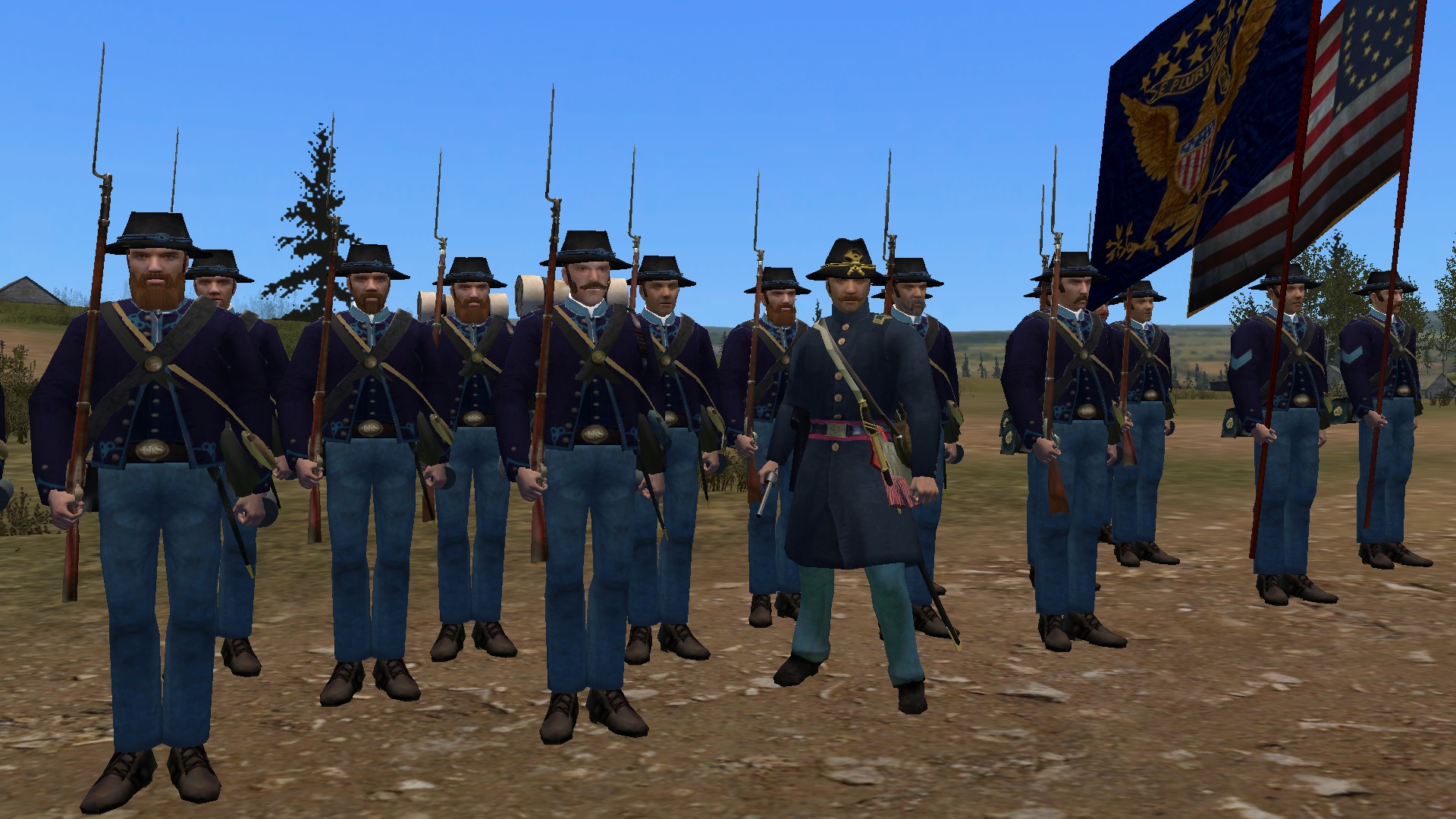
Weapons: Springfield Model 1861 Rifle Musket, Springfield Model 1863 Rifle Musket
Faction: Army of the Mississippi
Current Commander: Major General John A. McClernand
Recruitment Locations: Frankfort, Columbus, Cleveland, Cincinnati, Salineville, Camp Nelson, Lexington, Burkesville, Mount Sterling, Toledo, Fremont, Huntington, Wheeling, Parkersburg, Jackson OH, New Wilmington, Camp Dick Robinson, Findlay
In the American Civil War, Ohio provided the federal government with 260 regiments of men, including infantry, artillery, and cavalry units. Almost 330,000 Ohio men, including 5,092 African Americans, served in the Union military during the conflict. Governor William Dennison authorized the creation of the 53rd Regiment Ohio Volunteer Infantry on September 6th, 1861. Recruitment occurred at Jackson, Ohio and was not completed until January 1862.
On February 16th, 1862, the 53rd boarded a steamboat to Paducah, Kentucky, where the regiment joined the Third Brigade of General William T. Sherman's division. Sherman's command boarded steamers and sailed to Savannah, Tennessee, where the division disembarked and moved against the Memphis and Charleston Railroad near Iuka, Mississippi. Upon the expedition's conclusion, the 53rd entered camp near the Shiloh Church at Pittsburg Landing, Tennessee. On April 6th, 1862, more than three hundred of the regiment's enlisted men and one half of its officers were so ill that they were unfit for duty. On that day, a Confederate army attacked the Union Army of the Tennessee at Pittsburg Landing. In the resulting Battle of Shiloh, the 53rd performed admirably, slowly retreating on the engagement's first day with the rest of the Union army and driving the Confederates from the field on the second day. On April 8th, the regiment accompanied a cavalry battalion after the retreating Confederates. Confederate troops attacked the Union cavalry, capturing many of them. The 53rd launched a counter attack, freeing most of the prisoners and prompting the Confederates to withdraw. After this engagement, the regiment returned to their old camp at the Shiloh Church.
On April 29th, 1862, the 53rd Ohio departed Pittsburg Landing for Corinth, Mississippi, where the Union Army of the Tennessee besieged the city's Confederate garrison until May 30th, 1862. The regiment served in the siege lines, constructed numerous entrenchments, and fought the enemy in several engagements. Following the Confederates' evacuation of Corinth at the end of May 1862, the 53rd accompanied General Sherman on an advance to the Memphis and Charleston Railroad. The organization advanced through the Mississippi communities of Moscow and Lafayette, eventually arriving at Holly Springs, where the regiment helped drive Confederate soldiers from the community on July 1st, 1862.
On July 4th, 1863, the 53rd joined General William T. Sherman's advance upon Jackson, Mississippi. Union forces engaged the Confederates at the Big Black River and then besieged the garrison at Jackson. On July 17th, the city's Confederate defenders withdrew, giving control of Mississippi's capital to the Union. After a brief pursuit of the withdrawing Confederates, the 53rd entered camp along the Big Black River on July 20th, 1863. In mid-October, the regiment departed for Chattanooga, Tennessee, where the Confederacy's Army of Tennessee had besieged the Union's Army of the Cumberland. At Trenton, the 53rd was among the first Union forces in the town, driving Confederate soldiers from the community. The regiment entered Chattanooga on November 24th, 1863 and participated in the Battle of Missionary Ridge, helping Union forces to drive the Confederates from the ridge and to bring the Siege of Chattanooga to a victorious conclusion for the Union. The 53rd participated in the pursuit of the retreating Confederates as far as Ringgold, Georgia, before returning to Chattanooga.
On May 1st, 1864, the 53rd Ohio embarked upon General William T. Sherman's Atlanta Campaign. The regiment fought in many of the largest engagements of the campaign, including the Battles of Sugar Valley, Resaca, Dallas, Kennesaw Mountain, Nicojack Creek, and Atlanta. Following the Atlanta Campaign, the 53rd remained at Atlanta for a few weeks before joining the pursuit of Confederate General John Bell Hood’s army, which was advancing in the direction of Nashville. In mid-November 1864, the 53rd Ohio joined General Sherman's "March to the Sea." Upon reaching Savannah, the 53rd joined the Union assault on Fort McAllister on December 13th, 1864, driving the Confederate defenders from the fortification at bayonet point. The Union army occupied Savannah on December 21st, 1864, with the regiment entering camp in the city. In early February 1865, the 53rd Ohio embarked upon General Sherman’s Carolinas Campaign. In South Carolina, the regiment participated in several skirmishes with Confederate forces, including at Congaree, at the North Edisto River, and at Columbia. In early March 1865, the 53rd entered North Carolina, and participated in the Battle of Bentonville, North Carolina from March 19th to the 21st, 1865.
Following the surrender of General Joseph Johnston's Confederate army in late April 1865, the 53rd marched to Washington, D.C., where the organization participated in the Grand Review on May 24th, 1865. The regiment proceeded to Little Rock, Arkansas, reaching this city on July 4th, where officials mustered the command out of service on August 11th. During the 53rd Ohio's term of service, 80 men, including four officers, died from wounds received on the battlefield. An additional 196 men, including six officers, died from disease or accidents.

